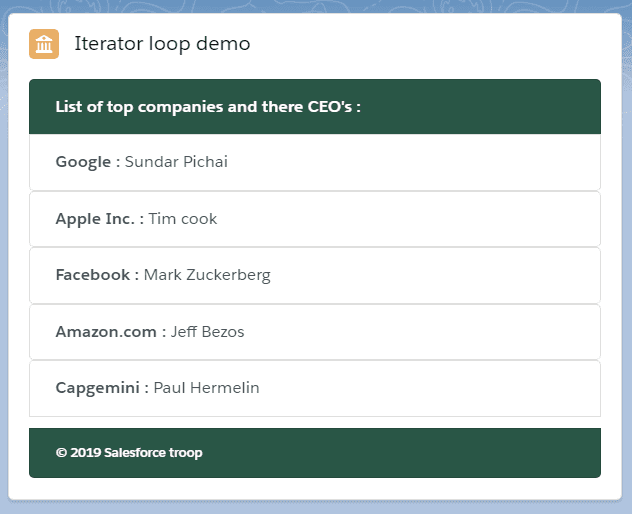iterator loop
There are many scenarios in which we have to render the same set of elements with the same styling with different data in the HTML. To solve this issue, we have template looping in the LWC.
There are are two types of directives by which we can achieve template looping.
1. for:each
2. iterator
use for:each directive or the iterator directive to iterate over an array.
In previous section we covered the for:each now we will cover the iterator loop
iterator loop
To apply a special behavior to the first or last item in a list we prefer iterator over for:each
Below is the syntax of the iterator loop
<template iterator:iteratorName={array}>
-----Here your repeatable template comes-----
</template>| Sno. | attributes | Description |
|---|---|---|
| 1. | iterator | It's a keyword to tell template that it's an iterator loop |
| 2. | iteratorName | iteratorName is the value of the current element in the loop. iteratorName is an alias and can be anyname |
| 3. | array | array is the data on which we want to apply loop |
Properties of iterator name
Using iterator name you can access the following properties
1. value — The value of the item in the list. Use this property to access the properties of the array. For example -iteratorName.value.propertyName
2. index — The index of the item in the list. For example -iteratorName.index
3. first — A boolean value indicating whether this item is the first item in the list. For example -iteratorName.first
4. last — A boolean value indicating whether this item is the last item in the list. For example -iteratorName.last
What is key and it's importance in the loop
- A
keyis a special string attribute you need to include to the first element inside the template when creating lists of elements. - Keys help the LWC engine identify which items have changed, are added, or are removed.
- The best way to pick a key is to use a string that uniquely identifies a list item among its siblings.
Note- The key must be a string or a number, it can't be an object. You can't use the index as a value for the key.
Example of for:each template looping
- In VS Code, open the Command Palette by pressing
Ctrl+Shift+Pon Windows orCmd+Shift+Pon macOS. - Type
SFDXand SelectSFDX: Create Lightning Web Component. - Type
templateLoopingIteratoras the name of the new component and pressEnter. - Again, Press
Enterto accept the defaultforce-app/main/default/lwc. - Goto your
lwcfolder, you will see one new component with the nametemplateLoopingIteratorgets created. - Create one more file inside the folder
templateLoopingIterator.cssfor styling. -
Let's add the following code to
templateLoopingIterator.html,templateLoopingIterator.js,templateLoopingIterator.cssandtemplateLoopingIterator.js-meta.xml
import { LightningElement } from "lwc";
export default class TemplateLoopingIterator extends LightningElement {
ceoList = [
{
id: 1,
company: "Google",
name: "Sundar Pichai"
},
{
id: 2,
company: "Apple Inc.",
name: "Tim cook"
},
{
id: 3,
company: "Facebook",
name: "Mark Zuckerberg"
},
{
id: 4,
company: "Amazon.com",
name: "Jeff Bezos"
},
{
id: 5,
company: "Capgemini",
name: "Paul Hermelin"
}
];
} <template>
<lightning-card title="Iterator loop demo" icon-name="custom:custom14">
<ul class="slds-m-around_medium">
<div class="list-group-inline">
<template iterator:ceo={ceoList}>
<div key={ceo.value.id}>
<a
href="#"
if:true={ceo.first}
class="list-group-item list-group-item-action header"
>
<strong>List of top companies and there CEO's : </strong>
</a>
<a href="#" class="list-group-item list-group-item-action">
<strong>{ceo.value.company} : </strong>{ceo.value.name}
</a>
<a
href="#"
if:true={ceo.last}
class="list-group-item list-group-item-action footer"
>
<strong>© 2019 Lightning school salesforce </strong>
</a>
</div>
</template>
</div>
</ul>
</lightning-card>
</template>
>.list-group {
display: -ms-flexbox;
display: flex;
-ms-flex-direction: column;
flex-direction: column;
padding-left: 0;
margin-bottom: 0;
width: 50%;
}
.list-group-item:first-child {
border-top-left-radius: 0.25rem;
border-top-right-radius: 0.25rem;
}
.list-group-item-action {
color: #495057;
text-align: inherit;
text-decoration: none;
}
.list-group-item {
position: relative;
display: block;
padding: 0.75rem 1.25rem;
margin-bottom: -1px;
background-color: #fff;
border: 1px solid rgba(0, 0, 0, 0.125);
}
.list-group-item:last-child {
margin-bottom: 0;
border-bottom-right-radius: 0.25rem;
border-bottom-left-radius: 0.25rem;
}
.header, .footer{
background: #295646;
color:white;
}<?xml version="1.0" encoding="UTF-8"?>
<LightningComponentBundle xmlns="http://soap.sforce.com/2006/04/metadata" fqn="templateLoopingIterator">
<apiVersion>46.0</apiVersion>
<isExposed>true</isExposed>
<targets>
<target>lightning__AppPage</target>
<target>lightning__RecordPage</target>
<target>lightning__HomePage</target>
</targets>
</LightningComponentBundle>iterator demo explanation
iteratoris taking an array of object namedceoListas input- we have used
ceoasiteratorNameto get the current item of an array - we are using iterator name propeties like
firstandlastto show header and footer in the list - To access the value of an Obejct we have to use
iteratorName.value property. for example -ceo.value.name - As key should be unique and in this case each object having an unique id. So, we are mapping the same. for example -
ceo.value.id templateLoopingIterator.cssyou can update based on your styling
Output
After placing the component on the page, you will see the following output.

